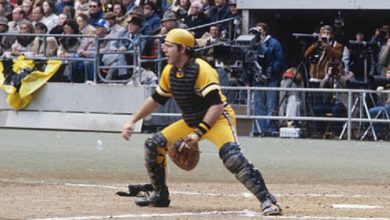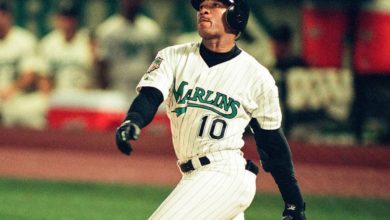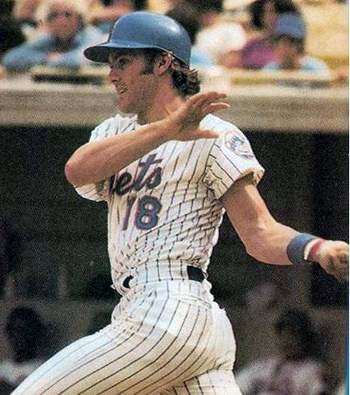
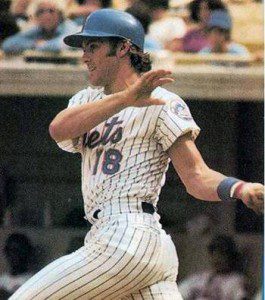
Thirty years ago, one of the more unusual events in major league history took place. On August 4, 1982, Joel Youngblood became the only player to ever to get a hit for two different teams in two different cities on the same day. What’s more, Youngblood got those hits off two future Hall of Famers: the Cubs’ Ferguson Jenkins and Phillies’ Steve Carlton. The strange day was the result of a deal between the New York Mets and Montreal Expos. The team from Flushing sent the versatile Youngblood to Montreal in exchange for a player to be named later (left-hander Tom Gorman).
In his 14-year major league career, Youngblood played for the Reds, Cardinals, Mets, Expos and Giants, hitting .265 lifetime, with 80 home runs and 422 RBIs. The Texan from Houston was an asset to any team defensively, as he could play any position on the diamond. In fact, he played every position on the field in his major league career except pitcher. Selected in the second round of the 1970 amateur draft by the Reds, the only time he ever worked behind the plate as a backstop was in a 1976 game against his future team, the Expos. Youngblood volunteered to be a receiver when the team’s two catchers were out of the game (Johnny Bench was pinch-hit for backup catcher Bill Plummer, who was ejected by the home plate umpire for arguing a called third strike). This came after admitting to Reds skipper Sparky Anderson that he had never caught in a single professional game.
After toiling for six years in the Reds’ farm system, including three at triple-A Indianapolis waiting for an opening on the big league roster, Youngblood finally made his big league debut. On April 13, 1976, versus the Atlanta Braves, he was inserted as a pinch runner for Bob Bailey in the Top of the eighth. On the season, he batted only .193 (11-for-57), and did not play in the Fall Classic sweep of the Yankees. Five years later, however, Youngblood played in the Midsummer Classic in Cleveland, as he was the Mets’ lone All-Star representative (he was 0-for-1 as a pinch-hitter). At the time of the strike that plagued the season in 1981, Youngblood unofficially led the league in hitting with a .359 batting average.
Youngblood was part of the “Midnight Massacre” trades of June 15, 1977, which to the pain of Mets fans sent their icon Tom Seaver to the Reds. The Mets made three deals that day. Seaver was dealt to Cincinnati for pitcher Pat Zachry, second baseman Doug Flynn, and outfielders Steve Henderson and Dan Norman. The team’s top hitter Dave Kingman was sent to the Padres for future Mets skipper Bobby Valentine, and Youngblood came to Queens from the St. Louis Cardinals for utility infielder Mike Phillips.
Youngblood’s ability to play multiple positions may have been a manager’s dream (in this case, the Mets’ Joe Torre), but the “super sub” was unhappy that he was never truly an everyday player, particularly in right field. In his first three seasons with the Mets he played at least six different positions a year. He also had value as a pinch-hitter, as he hit over .327 during that span. He didn’t like playing third base, where he was primarily used by St. Louis, and asked to play the outfield when he joined the Mets.
“Everybody talks about mental preparation in this game,” he said at the time. “Well, for so long I didn’t know where I was playing, what I was playing, if I was playing …”
In 1979, he led the club with 16 home runs and tied Lee Mazzilli for the team lead in games played with 158. His 18 outfield assists were second in the National League to the Cardinals’ George Hendrick’s 20. He also committed only five errors in 147 games in the outfield. Due to trades and injuries, however, Youngblood never truly became an everyday big leaguer.
On that early morning of August 4, 1982, Youngblood had no idea how long his day was going to be. It all started at Wrigley Field in Chicago when the Mets outfielder was starting in center field in place of an injured Mookie Wilson (Wilson was experiencing tightness in his leg). Batting third in the lineup versus Jenkins, Youngblood went 1-for-2. He struck out in the first inning against the right-hander, but followed that up with a two-run single in the third, giving his club a 3-1 lead. It was after the hit, which it turns out drove in the winning run, when he got the news.
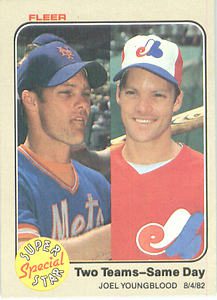 “(Mets manager George Bamberger) took me out of the game, I couldn’t understand it,” Youngblood said in 2007, marking the 25th anniversary of that day. “I went to talk to him, and he said, ‘Joel you’ve just been traded to the Montreal Expos — they’re short players and they’d like you to get to Philadelphia as quickly as you can.’”
“(Mets manager George Bamberger) took me out of the game, I couldn’t understand it,” Youngblood said in 2007, marking the 25th anniversary of that day. “I went to talk to him, and he said, ‘Joel you’ve just been traded to the Montreal Expos — they’re short players and they’d like you to get to Philadelphia as quickly as you can.’”
What Bamberger neglected to mention, however, was that the trade had gone down earlier in the day. Mets GM Frank Cashen had trouble getting connected by phone with the Expos, so he rolled the dice and risked a potential deal-breaking injury by allowing Bamberger to play the 30-year old Texan.
Scrambling to get to Philly for a 7:30 pm Eastern start, Youngblood showered, packed up his luggage and caught a cab to Chicago’s O’Hare airport. It was in the cab, however, where he realized he had forgotten one of his most prized possessions in the Mets dugout and had to turn around. “I left my glove at Wrigley Field,” Youngblood said. “And I knew it would take away from the time I had, and I was jeopardizing my opportunity to make that flight. But I’d played with that glove for years …”
Youngblood didn’t get to Veteran’s Stadium by game time, but arrived early enough to partake in the contest. “I got to the game about 8 p.m. It’s funny — I left there in the third inning, and I got here in the third inning.”
He was greeted by Expos manger Jim Fanning and placed in right field as a defensive replacement in the bottom of the sixth for Jerry White. It was in the seventh that he faced one of the game’s winningest southpaws in Carlton, and placed a single past Phillies second baseman Manny Trillo. Lifetime, Youngblood hit a healthy .329 (27-for-82) off Carlton, and 2-for-6 versus Jenkins. While he didn’t stick around for the conclusion of his first game, won by the Mets 7-4, he did finish the second game with his new team. However, his Expos lost to the Phillies, 5-4.
Youngblood is the only player to ever get a hit for two different teams on the same day. However, 60 years earlier, two players played for two different teams on the same day. Morning-afternoon doubleheaders were not uncommon in the 1920s, and on May 30, 1922, a Memorial Day swap took place between the Chicago Cubs and St. Louis Cardinals. Two left-handed outfielders, the Cubs’ Max Flack and Redbirds’ Cliff Heathcote switched dugouts between games. Neither player got a hit their first game (won by the Cubs 4-1), but both got hits in the second game for their new teams. Flack went 1-for-4 with the Cardinals and Heathcote was 2-for-4 with the Cubs. Chicago won the second game, as well, 3-1.
The events that transpired that day 30 years ago are not the only interesting moments in Youngblood’s 14-year major league career. In fact, Youngblood is more proud of what he accomplished as a Met, rather than simply being a footnote to history. In particular, it was a play he made on opening day at Shea Stadium in 1980. After coming in as a defensive replacement for Mike Jorgenson, Youngblood made a game-saving catch at the wall off the bat of the Cubs’ Larry Bittner. The fans gave him a standing ovation and the Mets prevailed, 5-2.
“I will never, ever forget that as long as I live,” said Youngblood. ” That, to me, is my best memory.”
His lengthy big league career ended in 1989. He appeared in 76 games that season with his original team, the Reds, following six seasons with the Giants.
Youngblood coached for several organizations, including the Orioles, Reds and Brewers. He did play briefly for the Sun City Rays of the troubled Senior Professional Baseball Association (in 22 games, he hit .326 with four homers and 16 RBIs before the league folded). Youngblood even managed. In 1992, he became skipper for the Kane County Cougars, a Class A affiliate of the O’s. Youngblood’s Midwest League squad finished in 10th place, with a 61-76 record.
Today he lives in Phoenix with his wife Becky and is the base running coordinator for the Arizona Diamondbacks.
Sources:
The 1976 Cincinnati Reds: Last Hurrah For the Big Red Machine, by Doug Feldmann, McFarland, 2009.
“A Star, Not A Starter: For An All-Star Joel Youngblood of the Mets Spends A Lot of Time On the Bench”, by Robert Sullivan, Sports Illustrated, August 24th, 1981.
“Twice as nice: 25 years later, Joel Youngblood looks at a whirlwind day,” by Jesse Spector, New York Daily News, August 5th, 2007.
“Today in Sports History: August 4th”, August 4, 2010” http://www.inhistoric.com/2010/8/4/1057469/today-in-sports-history-august-4th.
“Where Are They Now? Former Mets OF Joel Youngblood can still do it all”, by Mark Lelinwalla, New York Daily News, February 14th, 2009.
Baseball-reference.com.



